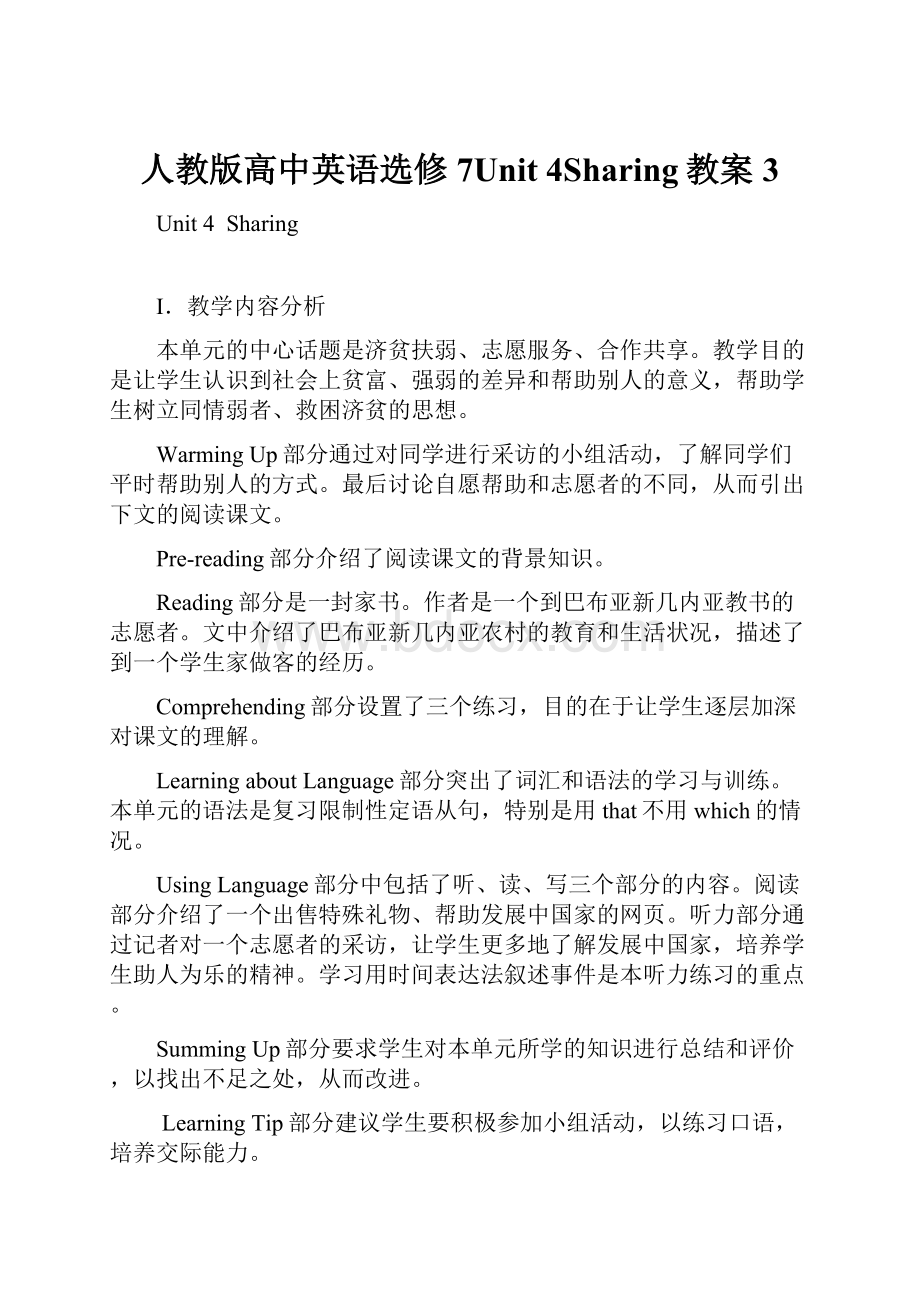人教版高中英语选修7Unit 4Sharing教案3.docx
《人教版高中英语选修7Unit 4Sharing教案3.docx》由会员分享,可在线阅读,更多相关《人教版高中英语选修7Unit 4Sharing教案3.docx(24页珍藏版)》请在冰豆网上搜索。

人教版高中英语选修7Unit4Sharing教案3
Unit4Sharing
I.教学内容分析
本单元的中心话题是济贫扶弱、志愿服务、合作共享。
教学目的是让学生认识到社会上贫富、强弱的差异和帮助别人的意义,帮助学生树立同情弱者、救困济贫的思想。
WarmingUp部分通过对同学进行采访的小组活动,了解同学们平时帮助别人的方式。
最后讨论自愿帮助和志愿者的不同,从而引出下文的阅读课文。
Pre-reading部分介绍了阅读课文的背景知识。
Reading部分是一封家书。
作者是一个到巴布亚新几内亚教书的志愿者。
文中介绍了巴布亚新几内亚农村的教育和生活状况,描述了到一个学生家做客的经历。
Comprehending部分设置了三个练习,目的在于让学生逐层加深对课文的理解。
LearningaboutLanguage部分突出了词汇和语法的学习与训练。
本单元的语法是复习限制性定语从句,特别是用that不用which的情况。
UsingLanguage部分中包括了听、读、写三个部分的内容。
阅读部分介绍了一个出售特殊礼物、帮助发展中国家的网页。
听力部分通过记者对一个志愿者的采访,让学生更多地了解发展中国家,培养学生助人为乐的精神。
学习用时间表达法叙述事件是本听力练习的重点。
SummingUp部分要求学生对本单元所学的知识进行总结和评价,以找出不足之处,从而改进。
LearningTip部分建议学生要积极参加小组活动,以练习口语,培养交际能力。
II.教学重点和难点
1.教学重点
(1)本单元的生词和短语;
(2)系统掌握运用限制性定语从句。
2.教学难点
(1)认识帮助别人的重要性;
(2)学会发表评论和表达自己的看法;
(3)学会以时间为线索,叙述人物生平。
III.教学计划
本单元建议分六课时:
第一课时:
Warmingup,Pre-reading,Reading&Comprehending
第二、三课时:
LearningaboutLanguage
第四课时:
Readinganddiscussing(UsingLanguage)
第五课时:
Listeningandspeaking(UsingLanguage)
第六课时:
Readingtask(Workbook),Speakingtask(Workbook)&Writingtask(Workbook)
IV.教学步骤:
Period1Warmingup,Pre-reading,Reading&Comprehending
TeachingGoals:
1.TohelpSstolearntheimportanceofhelpingothersandthewaystohelpothers.
2.TohelpSstolearnabouttheeducationalandlivingconditionsofsomedevelopingcountriesanddeveloptheirawarenessofhelpingthoseinneed.
3.Toteachhowtousethenewwordsandphrasesinthetext.
TeachingProcedures:
Step1.Leading-in
1.LeadSstothecontentofthisunit.Teachermaysay,“WehaveallheardaboutLeiFeng,whowasreadytohelpothersandsetusanexample.Weliveourownlives.Everybodyhashisownworktodo.Whymustwehelpothers?
”
2.GetsomeSstopresenttheiropinionsonthequestionabovebeforetheclass.
SuggestedAnswer:
Nobodycandoeverythingalone,nomatterhowpowerfulheis.Nobodynevermeetswithtrouble,nomatterhowwellheisgoing.Soeverybodyneedsothers’help.Butwecannotalwaysreceivebutnevergive.Wemustgiveinreturnforwhatwereceive.Wegivehelpbecausewehavebeenhelped.Sincewewereborn,wehavereceivedalotfromthesociety.Soweshouldreturnit.Wegivehelptoday,butwemayneedhelptomorrow.Evenifwemaynotseeapersonagain,byhelpinghim,wecanlethimknowhelpisnecessaryandimportantforthosewhoareinneed.Byhelpingeachother,peoplecanfeelthatlifeisfullofwarmthandfriendlinessandisworthliving.Inaword,tohelpothersistohelponeself.
Step2.WarmingUp
1.AskSstodiscussthefollowingquestion.
Inwhatwaysdowehelpthepeoplearound?
2.AskSstoworkingroupsoffourandoneofthemtointerviewtheotherthree.TellhimtoaskthequestionsinEx1ofWarmingUponP28.Thengetonepairtoactouttheirdialoguesbeforetheclass.
3.DivideSsintofourgroupsandaskthemtodiscussthefollowingquestion.
Canwecallthepersonwhohelpsothersa“volunteer”?
SuggestedAnswer:
Whenoneofyourparentsorfriendsneedshelp,youmaynotbeaskedtohelpbutyouvolunteertohelp,wedon’tsayyouareavolunteer.Avolunteerisapersonwhohelpsothersinoroutsidehiscommunityorinaforeigncountry.
Step3.Pre-reading
Purpose:
TogetSspreparedforthereadingtext.
1.AskSstolookatthepicturesonP29~P30andguesswhatthepassagetalksabout.
2.AskSstodescribethestudentsandtheirclassroomsinthepictures.Afterthat,letSsimaginetheirlivingconditions.
3.LeadSstothereadingtext.Teachermaysay,“TodaywearegoingtoreadaletterwrittenbyanAustralianvolunteer,Jo,whotaughtfortwoyearsinPapuaNewGuinea,acountrytothesouthofAustralia.”
Step4.Skimming
Purpose:
TohelpSsgetthegeneralideaoftheletter.
1.AskSstolistentothetapeandtrytogetthemainideaofthetext.
SuggestedAnswer:
Intheletter,thewriterwroteabouttheeducationalandlivingconditionsinPNGandherexperienceofvisitingastudent’svillage.
2.PlaythetapeparagraphbyparagraphandletSsreadafterit.Thenaskthemtosumupthemainideaofeachparagraphwithonlyonesentence.
SuggestedAnswer:
Para.2:
Theschoolissimplybuiltandfarawayfromthestudents’homes.
Para.3:
Theeducationalconditionsareverypoor.
Para.4:
Ivisitedavillageofoneofmystudent’andreceivedawarmwelcome.
Para.5:
Istayedwiththestudent’sfamilyandtheirhutswerepoorlyequipped.
Para.6:
Ihadamealwiththestudent’sfamilyandtheycookedinanunusualway.
Para.7:
Ireturnedfromthevisitandfeltgreatlyrewarded.
Step5.Scanning
Purpose:
TohelpSsgetadeeperunderstandingofthetext..
1.AskSstofindouttherelationshipofthepeoplementionedinthetext.Teachermaysay,“Therearesomepersonsmentionedinthetext.Canyounamethem?
Canyoufindoutwhotheyare?
”
SuggestedAnswers:
Jo—thewriteroftheletter.
Rosemary—thepersonwhoJoiswritingto.
Tombe—oneofthewriter’sboystudents,whosefamilyJovisited
Jenny—thewriter’sfellowworker
Kiak—Tombe’smother
Mukap—Tombe’sfather
2.AskSstoreadthetextcarefullyandaskthemthefollowingquestions.ItisbettertoreadthemouttoSsthantopresentthemontheblackboard.EncourageSstokeeptheeyesawayfromthebookswhentheyanswerthequestions.
(1)Whatistheschoollike?
(2)Isthewriterpopularwithherstudents?
Howdoyouknow?
(3)Whatisthewriter’sdifficultyinteaching?
(4)Whydidthestudentsjumpoutofthewindows?
(5)Whydoesthewriterwonderifsheismakinganydifferencetoherstudents’lives?
(6)Wasthewriterwarmlywelcomedbythevillagers?
Howdoyouknow?
(7)DoMukapandKiakusuallysleepinthesamehouse?
(8)WheredidthewriterandJennysleepthatnight?
(9)WhydidTombethrowawaythetincan?
SuggestedAnswers:
(1)Itismadeofbambooandtheroofsaremadeofgrass.ItisfromawayfromSs’homes.
(2)Yes.Whenshegetstoschool,thestudentsallsayhellotoher.
(3)Thereisnoelectricityorwaterandtheyhavenotextbooks.Thereisnoteachingequipment.
(4)Becausetheyhadneverseensuchanaccidentandwerefrightened.
(5)Becausemostofherstudentswillgobacktotheirvillagestoworkinthefieldandshethoughtwhattheyhavelearntwillbeofnouse.
(6)Yes.BecauseTmbe’smotherwelcomedherbycrying“ieeeieee”andthevillagerallshookhandswithherwarmly.
(7)No.Theysleepintheirownhuts.
(8)Theysleptonanewly-madeplatforminMukap’shut.
(9)Becausetheythinkthrowingawaythetincanisinfactthrowingawayevilspirits.
Step6.Languagepoint
1.AskSstoworkinpairsandunderlineandtranslatethefollowingphrasesinthetext.
hearfrom,bedyingtodosth.,upto,adaptto,theotherday,beforeIknewit,comeacross,makeadifferencetosb.,gettoknow,shakehandswithsb.,stickoutof,getthrough,anewlymadeplatform,acoupleof,buildafire,leave…todosth.,dryout,dryup,fallintobed
2.LeadSstodealwithsomemorelanguagepoints.
(1)bedyingtodosth(line2,para1):
wantverymuchtodosth,haveastrongdesiretodosth.
Iamdyingtoknowwhathashappened.我迫切想知道发生了什么。
●拓展bedyingforsth:
wantsthverymuch
Iamdyingforaglassofwater.我非常想来杯水喝。
(2)picture(line3,para1):
imagine,formapictureofsborsthinthemind
IcanstillpicturethehouseIspentmyhappychildhoodin.我仍能回忆起那间房子,在那里我度过美好的童年。
Canyoupicturewhatitisliketoliveonalonelyisland?
您能设想在孤岛上的生活是什么样吗?
(3)challenging(line4,Para.3):
difficulttodealwith
Iliketodochallengingwork.我喜欢做有挑战性的工作。
Tobeateacherisbothchallengingandrewarding.教师这个职业既充满挑战也能带来成就感。
(4)theotherday(line5,Para.3):
afewsaysago,recently
Isawapersonswimmingintherivertheotherday.那天我看见一个人在河里游泳。
(5)makeadifferenceto(line10,Para.3):
haveaneffecton,beimportantto
Theraindidn’tmakeanydifferencetoourfootballgame.那场雨没有影响到我们的足球赛。
Goingtocollegemadeabigdifferencetomywholelife.考上大学对我的整个一生影响颇大。
(6)stickout(line2,Para.5):
pushsthfurtherout
Don’tstickyourarmoutofthecarwindow.不要把手伸出车窗。
Shestuckouthertongueatme.她向我吐舌头。
(7)acoupleof(line10,Para.5):
①two;②afew,asmallnumberof
Isawacoupleofthemgetout.我看见他们俩出去了。
Wewentthereacoupleofyearsago.我几年前去过那。
(8)leavesbtodosth(line4,Para.6):
leavesbbehindandmakehim/herdosth
Allmenhavegonetotowntomakemoney,leavingthewomentodothefarmwork.男人都去城里挣钱了,把农活都留给女人去做。
(9)preparesb./sth.(thelastparagraph.):
getsb./sth.ready
Motherisbusypreparingdinnerinthekitchen.妈妈正在厨房里忙于准备饭菜。
Theteacherstayedlatetopreparelessonsforthenextday.老师为备课,加班到很晚。
3.GetSstofindtheattributiveclausesusedinthetextandtranslatethemintoChinese.AndthenexplainforSs.
(1)WhenIreachtheschoolgrounds,therearelotsof“goodmornings”fromtheboys,manyofwhomhavewalkedalongway.当我到达学校时,许多男孩向我对我说“早安”。
他们中有许多人是走了很远的路来上学的。
manyofwhomhavewalkedalongway是非限制性定语从句,起补充说明作用。
试对比:
...fromtheboys.Manyofthemhavewalkedalongway.(单句属于独立的句子,地位和前一个句子相同。
)
(2)SometimesIwonderhowrelevantchemistryistothekids,mostofwhomwillbegoingbacktotheirvillagesafterYear8.有时我很想知道化学与这些孩子有什么关系,因为他们中的大多数人在8年后都会返回他们的村子。
mostofwhomwillbegoingbacktotheirvillagesafterYear8.是非限制性定语从句,处于次要地位,起补充说明作用。
(3)Wewalkedfortwoandahalfhourstogetthere—firstupamountaintoaridgefromwherewehadfantasticviews.我们走了两个半小时才到那——先翻过一座山又过了一座桥,在那里我们看到了美丽的景色。
fromwhere=fromontheridge,例如:
Hehidhimselfbehindthewall,fromwherehecouldwatchtheenemy.(where=behindthewall)他藏在墙后面,在那他可以看见敌人。
Step7.Homework
1.AskSstoreadthetextaloud.
2.AskSstofinishEx1andEx3ofComprehendingonP31.
3.AskEx1andEx2